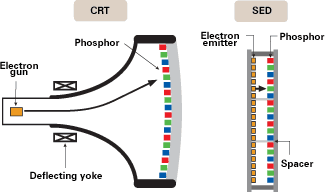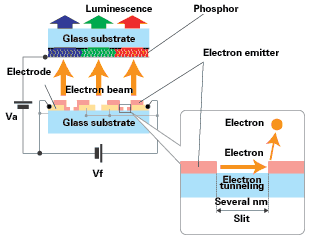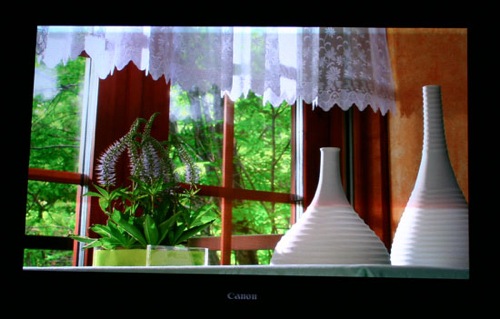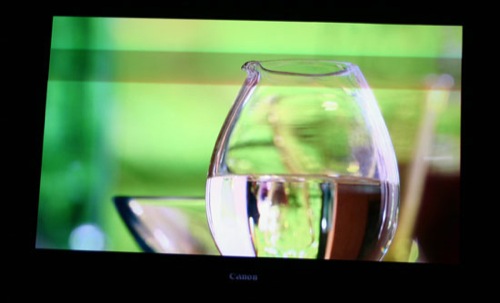CES 2006 - Day 3: Playstation 3, Quarter-size Hard Drives, SED and lots of TVs
by Anand Lal Shimpi & Manveer Wasson on January 9, 2006 1:25 AM EST- Posted in
- Trade Shows
Canon and Toshiba Demonstrate SED TVs
Canon and Toshiba have been working on yet another display technology called SED (Surface-conduction Electron-emitter Display). The goal of SED is to bring some of the good qualities of CRT displays (response time, brightness, black levels) to a fixed pixel, very thin, low power display.
The technology works very similarly to older CRT displays, except on a much smaller scale. In a CRT display a Cathode Ray Tube (CRT) would shoot electrons at phosphors behind the viewing glass to effectively paint the picture you see on your monitor. In a SED display, individual electron emitters shoot electrons on phosphors behind the viewing screen to create the pixels on your screen.

CRT vs. SED - provided by Canon Technology

How SED Works - provided by Canon Technology
Since a large CRT isn't necessary, SED TVs can be several centimeters thick rather than tens of inches. But with the response time, brightness, color reproduction and black levels comparable to CRT displays, SED technology has the potential to be the best of both worlds.
Like LCD and DLP technologies, SED displays are fixed pixel displays and there are three electron emitters per pixel. The downside to a fixed pixel display of course is that you end up sacrificing quality if you display content isn't at the same resolution as the native resolution of your display. In other words, there should be a 1:1 mapping of content pixels to each group of RGB electron emitters to obtain the absolute best image quality. However, as hardware scalers become more and more powerful the 1:1 pixel mapping problem becomes less important.
About six years ago Canon and Toshiba started working on developing SED technology for consumer TVs, and they are supposed to start shipping the first SED panels later this year. At the show both companies had demos of SED TVs (they looked to be around 30" diagonally). The conditions weren't perfect to truly evaluate the technology since they were in extremely dark rooms and with no other displays available for direct comparison. That being said, the image produced looked very nice. With no other types of TVs in the room we can't really say how it compared to LCD or Plasma TVs (SED's closest competitors), but it did look very good.

One thing we did notice was that the displays looked like they had extremely low refresh rates. You could see the screen refreshing much like a CRT set to 60Hz. Granted the technology is still pre-production so that could explain the issue.

The dark bar across the screen is our camera capturing the visible refresh rate on the display










45 Comments
View All Comments
JarredWalton - Monday, January 9, 2006 - link
Looks fine for me with Firefox 1.07, but Internet Explorer is all messed up. The odd thing is that it's only *this* article that's having problems.Oop... found the issue. The article description had a double-quote in it, and changing that to " fixed the problem. Thanks for pointing this out!
tuteja1986 - Monday, January 9, 2006 - link
http://www.theinquirer.net/?article=28840">http://www.theinquirer.net/?article=28840world largest is panasonic not samsung :)
Samsung 102"
Panasonic 103"
So as you can see Panasonic wins by 1" ...lol
Cygni - Monday, January 9, 2006 - link
I just cant see how anybody really expected HD-DVD or Blu-Ray to be a success, to be quite honest. They seem to be expecting everyone to dump all their "old school" DVD's to pick up the SAME titles in the new formats, like most people eventually did with the VHS->DVD move... but i think its quite obvious that there just isnt any motivation to DO that this time.Can you say Laserdisc anybody? I just dont see Blu-Ray or HD-DVD taking off like they think it will. Will they stick around in the long run, unlike Laserdisc? Probably, simply because the added storage will be useful in the long long run and the discs/drives should eventually be dirt cheap... but they ARENT going to be a run away, must upgrade success. Thats for sure.
And when can i get a 103" OLED display? :p
Chadder007 - Monday, January 9, 2006 - link
:werd:I thought this was hillarious
Blu-Ray AND HD-DVD will be a failure.
sprockkets - Monday, January 9, 2006 - link
It just confirms what I have been saying, recording HDTV to DVD on 720x480 doesn't look that much worse than it coming on 1920x1080 live.Sure the original was smoother and clearer, but, it wasn't mind blowing, and if I didn't tell you, you probably wouldn't notice the difference either.
gsellis - Monday, January 9, 2006 - link
First, thanks to the AT crew for going out of their way on such a horrible journey to cover this event. We all know you had to suffer to do it, but anything for the AT user's, right? ;)On the DVD to HD-DVD/Blu-Ray compare, their content did not show much difference because of the source. The played content was probably film of Pro-HD and compressed to MPEG or HD codec with a high-end encoder (the reds in that closest did not appear to be crushed as much as a standard encoder would do with something like DV content.) It looks like the source was at least 4:2:2 and maybe 4:4:4.
If the sources had been DV vs HDV, their would have been a little more dramatic. And as noted, if it had been compared to NTSC 480i, it would have also been more dramatic.
But, you are very correct in that this is not VHS-DVD where the quality jump is higher and the feature set is bigger. DVD is non-linear in how you can view content compared to tape and the big bonus was adding the bonus material. The bonus material is already there, so what can they add to really make it worth it? Especially when the players can do upconverts? And 720p movies fit on DL DVD-ROM already.
OK, (maybe coining a new twist on an old term or it probably has be done) having a Blue disc player and replacing your DVD library makes your v-penis(tm) bigger :p
MrSmurf - Monday, January 9, 2006 - link
You can play your current DVDs in the newer standards. I think both will have moderate success on the PC once the price goes down due to their size but it'll be some time both stand alone players even put a dent in the market.Xenoterranos - Monday, January 9, 2006 - link
Hellz yeah. I wouldn't mind that 82 in LED lit LCD either, probably the closest you can get to a big screen OLED screen right now.OddTSi - Monday, January 9, 2006 - link
Someone please fix the page formatting. Everything is all over the place.JarredWalton - Monday, January 9, 2006 - link
Should be fixed now.